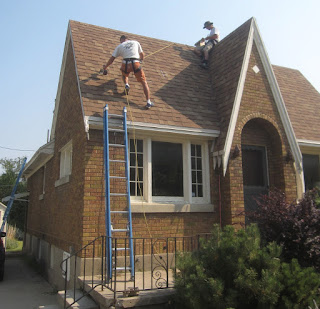But nobody in Utah seems to be in the business of retrofitting old houses with practical solar space-heating systems (and designing such a system from scratch, though tempting, would be incompatible with holding down a day job for a clumsy tinkerer like me). Meanwhile, PV keeps getting cheaper, and Utah has a generous 1:1 net-metering policy, plus a 25% state tax credit on top of the 30% federal tax credit. The last straw was the Susie Hulet Community Solar program, which offers attractive pricing that scales down linearly (except for the city permit fee) to arbitrarily small installations. With the encouragement of my colleague John Armstrong and the good people at Utah Clean Energy, I signed up as soon as the program got up and running, at the end of May.
(At about the same time, I also got a bid from another reputable installer who apologized for not being able to offer me a decent price on such a small system, and suggested I look into the Susie Hulet program instead.)
Apparently I wasn’t the only one who signed up as the program began, because it took the contractor (Gardner Energy) several weeks to process all the applications, conduct site visits, and prepare contracts. On July 9 they gave me my installation date: August 19. Then I patiently waited while the summer sun beat down on my roof.
Finally the day arrived, and the Gardner truck pulled up to my curb with four solar panels strapped to the bed and a trailer full of tools in tow:
The crew of three wasted no time getting to work. Chad and Chase got up on the roof, tied themselves to the chimney, and began installing mounting brackets:
Back on the roof, the mounting rails came next:
By lunch time the mounting hardware was all in place, along with most of the electrical components:
Each of the four panels gets its own Enphase M250 microinverter:
After lunch, Patrick installed the second electrical box:
And before long it was time to hoist up the first of the four SolarWorld Sunmodule Plus 280-watt mono black panels:
The three remaining panels quickly followed:
The system came with this cool monitoring unit, which reads data from the inverters off the power line, displays the current power level, and beams it via wifi onto the internet:
The solar system connects to a new 240-volt breaker in my electrical panel:
The city inspector came to check the wiring just five days after the installation. Then, after three more days, Rocky Mountain Power installed my new net meter:
The meter’s LCD display blinks between showing the energy I’ve pulled off the grid and the energy I’ve pushed onto it. So far, after ten days, those numbers are 25 and 37 kilowatt-hours, respectively. But the Enphase monitor data says I’ve generated a total of 51 kWh during this time, so I must have used another 14 kWh as it came off the solar system, which the meter never saw.
Gardner predicts that this system will generate a total of 1657 kWh per year, and I’ve been using only about 1400 kWh/year, so in a sense I can now claim that “all” of my home’s electricity is solar. But only a fraction of the solar energy is being produced when I need it, so I’m still very much dependent on the grid, and on the coal- and gas-fired power plants that power that grid through the nights and cloudy days.
What about cost? The sticker price of my solar system came to $4251.41, including $260.61 for the Ogden City permit. But I expect to recover 55% of the cost through the federal and state tax credits, so my net up-front cost should be a little over $1900. Under the current rates and net-metering policy I should save about $10/month on my electricity bill (I’ll still pay the $8 minimum monthly fee), so the system would pay for itself in 16 years if rates and policies don’t change. Inevitably the rates and policies will change over that time, so my $1900 investment is rather risky.
If you’re thinking of installing your own solar system, be aware that the return-on-investment calculation depends on all sorts of details that will vary from one installation to another. In all cases, however, we’re talking about thousands of dollars. Before you even consider spending that kind of money, I would strongly urge you to invest the effort to find and eliminate wasteful electricity uses in your home. Mr. Money Mustache has a great article on how to do that. Get yourself a Kill-a-Watt meter at the very least!
Finally, from a broader perspective, let me point out that it’s not very efficient to pay young men to risk their lives up on roofs, installing solar panels a few at a time. At least in Utah where electricity is cheap, the rooftop solar business is viable only because of the tax incentives—and even then, it works only for homeowners with suitable, unshaded roofs and cash to invest (or at least good credit). If the goal is to reduce carbon emissions, it would be far more efficient for society to invest in utility-scale solar farms. Then the economy of scale, ease of installation, and optimized siting would make government subsidies superfluous. But here in Utah our elected officials don’t even believe global warming is real, while they’re happy to provide government subsidies to well-off rugged individualists. So for now, rooftop is the only solar game in town.





